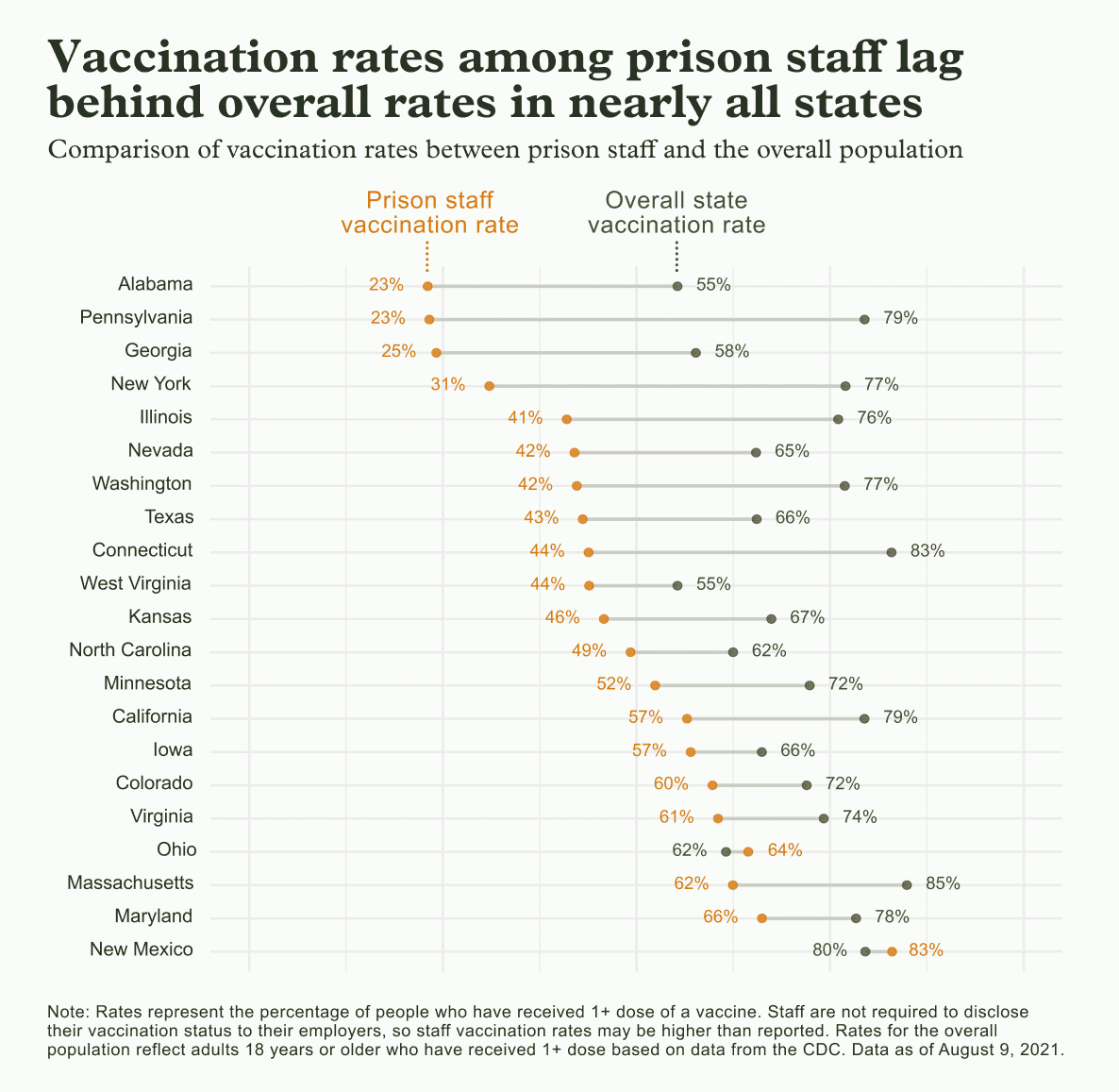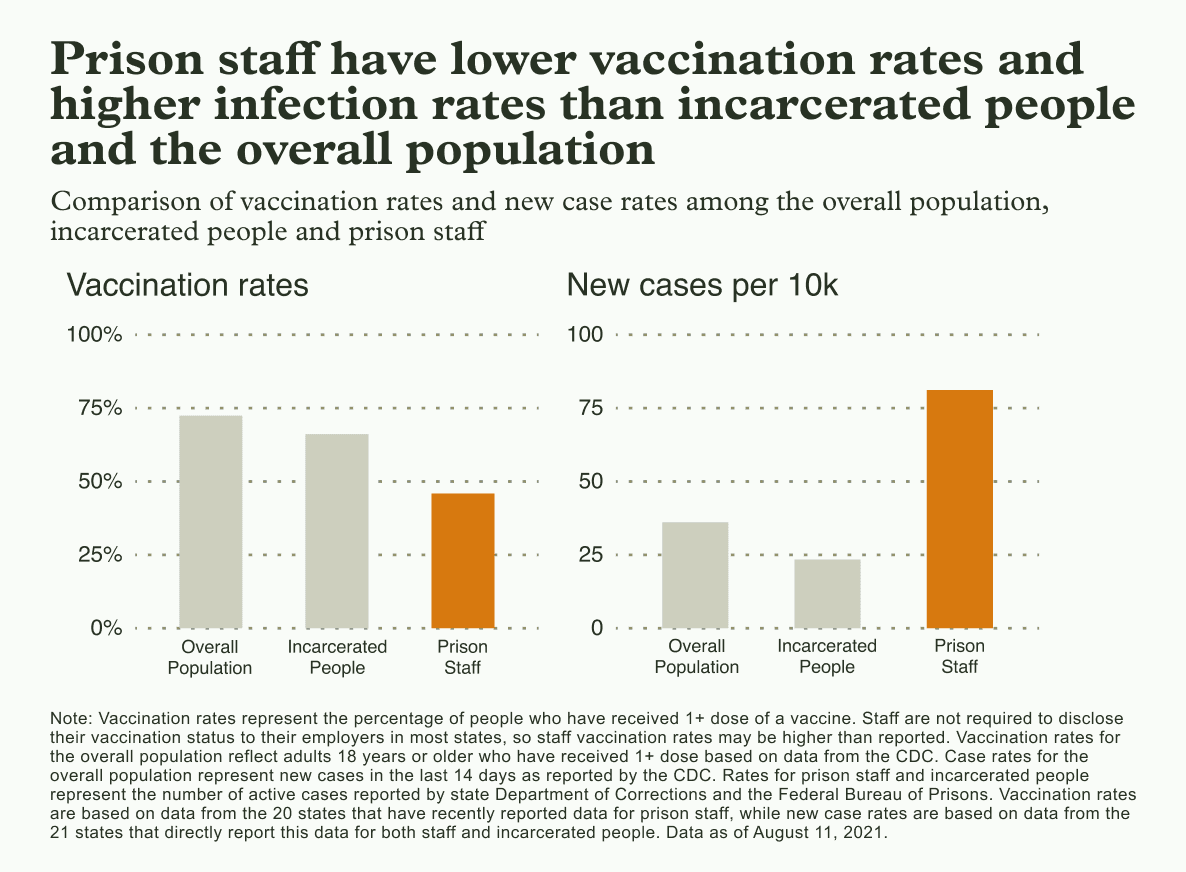August 12th, 2021 • Erika Tyagi and Joshua Manson
Prison Staff are Refusing Vaccines. Incarcerated People are Paying the Price.
In recent weeks, as the Delta variant has surged across the country, the rates of infection among prison workers are on the rise, while their vaccination rates remain dangerously low.
Of course, these trends are not unrelated. It’s now well-established that vaccines are highly effective at controlling the spread of the new variants of COVID-19, providing protection that is particularly critical in congregate settings like jails and prisons — places where maintaining physical distance is often impossible, and just one infection can cause massive outbreaks.
As infection rates climb, prisons are extending — and, in some cases, reimposing — restrictive measures that keep incarcerated people on lockdown for as many as 23 hours per day, without access to programming or in-person visits. This continues even as vaccination rates among incarcerated people are higher than the national average in many states, and much higher than that of prison staff.
It is now becoming increasingly clear that as long as large swaths of prison staff refuse vaccines, incarcerated people will not only remain vulnerable to infection and death, but will continue to be subject to harsh isolation measures because of staff intransigence.
Prison staff have refused vaccines at very high rates
We estimate that, to date, just 47% of prison staff have received at least one dose of a vaccine, based on data from the 21 agencies that have recently reported this information. By comparison, more than 71% of all adults in the U.S. — and 64% of incarcerated people — have been vaccinated so far.
In several states, staff vaccination rates are much lower than the national average. In Alabama, Pennsylvania, and Georgia, fewer than 25% of prison staff report being vaccinated. In these states, more officers have tested positive for COVID-19 over the course of the pandemic than have reported getting a vaccine. In nearly all states that report data, staff vaccination rates lag behind the overall rate among adults by a considerable margin.

In Pennsylvania — where 80% of all adults and 88% of incarcerated people have been vaccinated — none of the state’s 24 prisons reports a staff vaccination rate above 50%. Just 8% of officers working at SCI Albion in Erie County have reported getting a shot. At SCI Smithfield in Huntington County, this number is just 7%.
These low vaccination rates are especially concerning given that incarcerated people often cannot create distance between themselves and prison staff. They’re also alarming because prison employees themselves have had much higher infection rates than the country’s population as a whole.
It is possible that true staff vaccination rates may be higher than reported, but because of agency data collection and reporting failures, we cannot know. The head of the Pennsylvania State Corrections Officers Association has said that he believes more officers have been vaccinated from outside health providers, but are choosing not to report their status to prison officials. In several other states, agencies have also suggested that reported data may undercount the true number of staff that are vaccinated.
This failure to report accurate and timely vaccination data presents its own threat to public health and safety: policymakers and the broader public must know if and where large groups of unvaccinated individuals are regularly congregating in crowded environments already proven to be virus incubators. People with family members in prison should know if the people with whom their loved ones interact everyday, and with whom they might interact while visiting, remain unvaccinated.
New cases are increasingly concentrated among staff, and incarcerated people are suffering the consequences
Over the last several months, agencies have reported much higher rates of active infections among employees in prisons than among incarcerated people. This is the direct consequence of allowing large numbers of employees to continue to work in prisons without receiving vaccinations.
Based on data from the 21 states that report this information, we estimate that, as of August 11, the active infection rate among prison staff nationally is 81 cases per 10k. This compares to just 23 cases per 10k among incarcerated people and 36 cases per 10k among the overall population in the U.S. In Pennsylvania, Illinois, California, and Texas, the active infection rate among prison staff is more than twice the rate among the overall population in the state.

In total, the number of cases reported each week in prisons is still far lower than it was during earlier waves of the pandemic (although several agencies, including in Florida and Georgia, have altogether stopped reporting data from prisons in recent weeks, making it impossible to know the true number of new infections inside). Still, of the new cases that agencies are reporting, a much higher share have come from staff, rather than incarcerated people.
Over the first 12 months of the pandemic, less than 25% of cases reported in state prisons were from staff who tested positive. Since April 2021, staff have accounted for more than 40% of new infections inside these facilities each week.

Now, with rising cases on the outside and unvaccinated staff likely serving as vectors bringing the virus into prisons, agencies are reimposing restrictive measures on their incarcerated populations, including suspending visitation and programming. It is unclear, however, exactly who these measures are designed to protect — the mostly vaccinated incarcerated population, or the mostly unvaccinated staff population.
In Louisiana, the Department of Corrections suspended visitation on July 27, citing “the latest surge of COVID-19 positive cases.” At the time of the announcement, the agency reported 26 active cases among staff but zero among those incarcerated across the state’s entire prison system. That same day, the Mississippi Department of Corrections also suspended visitation across the state’s prisons, despite reporting vaccination rates between 82% and 99% for incarcerated people in its press release. Advocates in Pennsylvania have pointed out that incarcerated people, 88% of whom are vaccinated, are still facing strict lockdown restrictions in several prisons that may be “causing more harm than they are good.”
Vaccine mandates for prison staff are long overdue
For more than eight months, agencies have failed to increase voluntary vaccinations among their employees to necessary levels. Despite being granted priority access to vaccines in nearly all states, and despite being offered incentives to receive vaccines, too many have been unwilling to accept a vaccine in the absence of mandates.
In recent weeks, medical experts have voiced their support for vaccine mandates for health care workers, noting the ethical obligation of medical professionals to ensuring the health and well-being of the patients whose care they are entrusted to protect. Prison staff are similarly entrusted with the health and safety of incarcerated people, but governors have implemented such mandates in only a handful of states, including California, New York, New Jersey, and Illinois.
Last week, a court-appointed official overseeing medical care in California prisons recommended to a federal judge that the California Department of Corrections and Rehabilitation (CDCR) implement a mandatory vaccine policy — a step beyond the governor’s order requiring vaccination or the option of weekly testing.
“Institutional staff are primary vectors for introducing COVID‐19 into CDCR facilities. This is not a criticism, it is simply a fact,” wrote J. Clark Kelso, federal receiver for the CDCR medical system. “Voluntary [vaccination] efforts have not produced acceptable results and continuation with a voluntary approach that yields such results must be acknowledged for what it has proven to be — an unacceptable half‐way measure.”
When COVID-19 vaccines were first approved, prison staff were rightfully granted high prioritization for vaccine eligibility. Now, as more and more federal and state employees are required to receive vaccines, prison staff should be, too. There is no reason that incarcerated people — who often cannot social distance but have chosen to receive vaccines in large numbers — should pay the price for staff refusals, either through suspended privileges or through needless infection and death.
Note: In addition to the data that we collect directly from agencies, we have also included information on vaccination numbers and rates from news sources for this analysis. Data reflect the most recent information available as of August 11, 2021. See here for more details.
next post
August 20th, 2021 • Sharon Dolovich, Erika Tyagi, and Neal Marquez
The states that lead the nation in COVID-19 cases are hiding their prison data
As the Delta variant causes surges across the country, the states with the greatest increases in new cases are also the least transparent about the spread of COVID-19 behind bars.